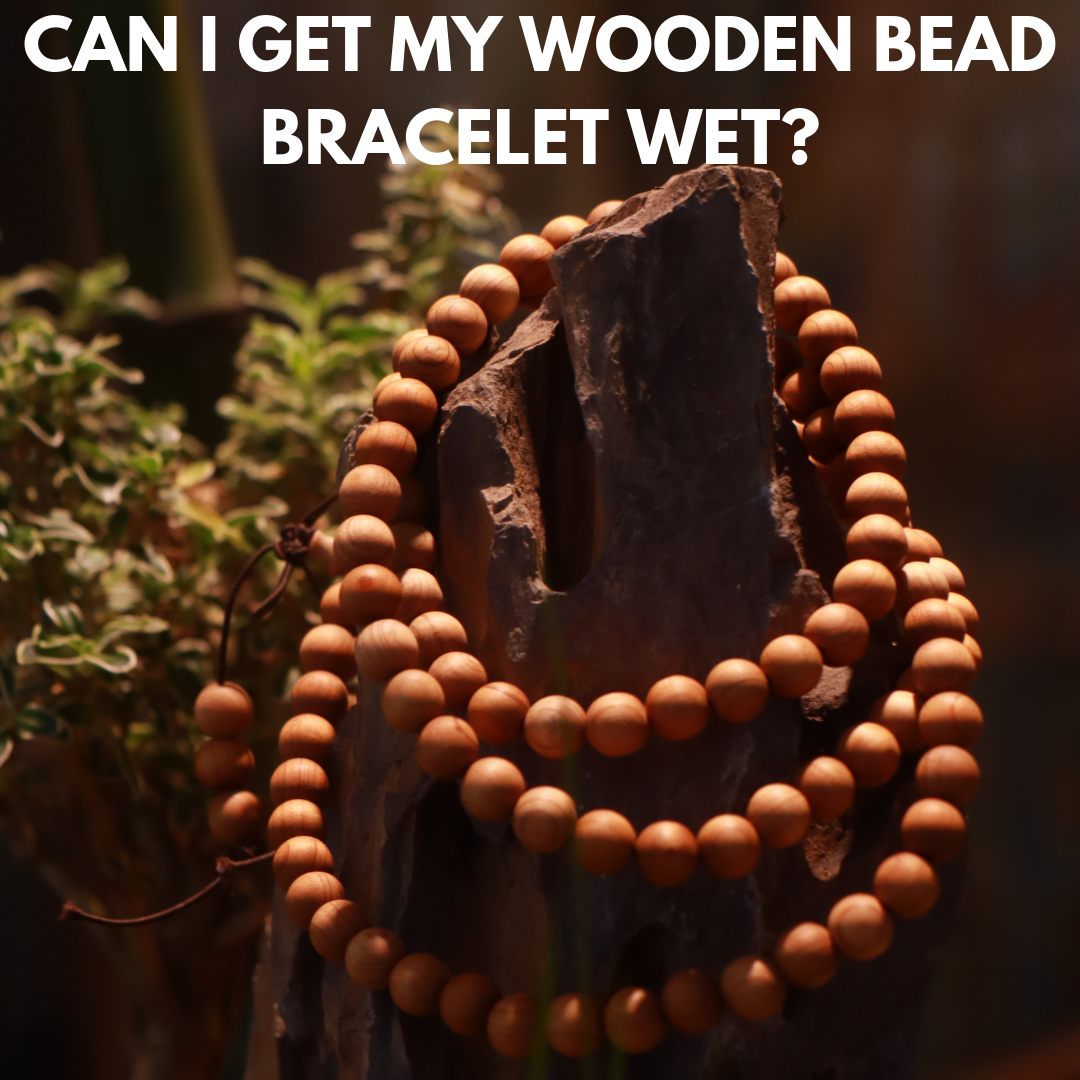Wooden bracelets hold an exclusive place among accessories, with their natural charm, eco-friendliness and cultural significance making them popular choices among many people. However, wood's porous nature presents one challenge when exposed to moisture; proper care must be taken after water exposure so as to maintain both the beauty and longevity of these timeless accessories. This blog series on waterproofing wooden bracelets will examine water resistance properties, care methods after exposure as well, and innovative approaches that improve their longevity over time.
Water Resistance Properties of Wooden Bracelets
Wood, as an inherently porous material, absorbs moisture from its environment through absorption, which in turn causes swelling that leads to cracking, warping and brittleness over time. Prolonged exposure also increases mold or mildew growth potential in humid conditions.
Wooden bracelets worn during rainstorms could absorb rainwater and slowly change in texture and structure over time, ultimately shortening their lifespan and aesthetic appeal.
Importance of Surface Treatment
To combat wood's natural absorption properties, many wooden bracelets undergo surface treatments like sealing or polishing in order to create protective layers against water penetration and absorption. These treatments act like barriers against further water ingress by applying protective layers that form barriers against its penetration into the bracelet's material structure.
While these methods do increase water resistance for wooden bracelets, they don't completely waterproof them over time due to wear and tear; regular applications will likely be necessary in order to preserve their protective qualities.
Care of Wooden Bracelets After Water Exposure
Accidental exposure can happen; knowing how to care for it promptly is of vital importance for its preservation.
Immediate Drying
To quickly restore wooden bracelets that become wet, use an absorbent fabric cloth with soft fibers to absorb excess liquid and gently wipe its surface away. Avoid harsh rubbing as this could damage or scratch them further.
At room temperature, allow the bracelet to dry naturally without using high-heat tools like hairdryers or placing it directly under sunlight; excessive heat could warp or crack the wood and require it to be cut back down again later on.
Apply Natural Oils
Once dry, using a small amount of natural oils such as coconut or olive can restore a bracelet to its former luster and help safeguard its future exposure to environmental conditions. Coconut and olive oils both replenish lost moisture as well as create a protective shield that guards against further wear and tear.

Apply a few drops of oil using either a clean cloth or your fingers and let sit overnight before buffing away excess. This simple step can rejuvenate wood surfaces while keeping them looking their best!
Prevention Is Better than Cure
Preventative care can save your wood bracelet from damage by adopting these daily habits to safeguard it against wear.
1. Avoid Moist Environments
Moisture can wreak havoc with wood jewelry over time, weakening it over time. Exposing daily to humidity could eventually weaken it even more than anticipated.
Before Engaging In Wet Activities: Always take precautions before engaging in water-intensive activities, such as handwashing, showering or doing dishes involving any amount of moisture that might seep into the wood and cause swelling or discoloration. Even small amounts can soak through and cause swelling or discoloration to the bracelet itself.
Monitor Humidity Levels: Humidity isn't only a problem in bathrooms or kitchens - it can have adverse effects when worn outdoors on humid days or stored in damp rooms. Consider placing a dehumidifier or silica gel packets in your storage area in order to manage moisture levels effectively.
Be Wary of Sweat: Wearers of wooden bracelets during workouts or hot days need to be wary of sweat, which acts like moisture to penetrate its wood material and damage its integrity. Clean your bracelet regularly after exposure Let it dry completely in the air before putting it away for storage. future use.
2. Minimize Chemical Exposure
Exposure to everyday products that contain chemicals may erode the finish on wooden bracelets and cause their natural texture and protective coatings to break down over time, rendering them nonfunctional and vulnerable.
Limit Contact with Cosmetics: Wearing your wooden bracelet when applying lotion, sunscreen, or perfume may leave a residue that dulls the finish and leads to lasting blemishes on its finish.

Keep Away From Cleaning Products: Before using household cleaners, disinfectants or alcohol-based products on wood jewelry such as bracelets, it is advisable to take steps to safeguard them against accidental contact with these substances - these substances could erode protective treatments and change their color over time, potentially harming protective treatments as well as altering natural grain patterns of wood grains.
Opt for Alcohol-Free Products: When selecting products such as hand sanitizers to wear with the bracelet, ensure they are alcohol-free in order to minimize damage.
3. Proper Storage Practices
How you store your wooden bracelet is just as crucial to its care as how it is - proper storage protects against environmental stressors and accidental damage to its structure.
Choose a Dry and Cool Space: Store your bracelet in an area protected from direct sunlight, as well as areas with moisture, such as bathrooms. Overexposed to sunlight will eventually fade its hue, while moisture increases its risk for swelling or mold growth.
Protective Containers: Consider investing in a jewelry box with compartments or a soft pouch to shield delicate accessories from accidental scratches from other accessories, particularly bracelets with intricate carvings or designs that require extra padding to remain undamaged by pressure and chips.
Avoid Overcrowding: When it comes to jewelry storage, ensure each piece has enough breathing room in between each one for proper organization and care. Wooden bracelets tend to be more fragile and easily marked up from coming into contact with harder surfaces compared to metal ones.
Use Moisture Absorbers: Add moisture absorbing items such as silica gel packets or small packets of dried lavender into your storage box to absorb any extra humidity while simultaneously contributing a pleasant scent and scenting the space. These measures will not only help absorb excess moisture but will help create a pleasant scent in your storage unit!
4. Clean Your Bracelet Regularly
Daily wear can leave a bracelet covered in dirt, oils or sweat that needs regular cleaning in order to remain looking its best and avoid long-term damage. Regular cleaning helps it look clean as well as prolongs its useful lifespan, and ensures longer-term damage prevention.
Wipe Your Bracelets After Each Use: At the end of every day, wipe down your bracelet gently using a soft and dry cloth in order to eliminate surface dust or oils that have collected on its surface, as this quick step prevents grime accumulation over time.
On a monthly basis, perform a more in-depth deep clean using a damp (not wet) cloth with mild soap added as necessary to gently wipe surfaces down before drying quickly afterward. Once complete, follow up by lightly applying natural oil for enhanced luster restoration.
5. Switch Your Jewelry Over Time
Wearing one wooden bracelet on an everyday basis can increase wear and tear on that piece; by switching up how often you use different pieces, you can reduce strain on one bracelet at once.
Allow Your Bracelet To "Rest": Like other natural materials, wood needs time off from wear and tear in order to extend its lifespan and ensure its future use. Giving it this luxury will only extend its longevity!
Seasonal Awareness: When wearing your bracelet in humid regions such as monsoon season or summer (in terms of moisture or sweat) for too long periods, take extra caution in terms of its exposure to moisture or sweat. Consider wearing it less frequently so as to limit how often its surface area comes into contact with water or sweat.
Modern Innovations Open Up New Doors for Better Water Resistivity
Innovation has opened doors for creating wooden bracelets more resistant to moisture than ever. By blending traditional craftsmanship with cutting-edge materials and techniques, the functionality of wooden jewelry is greatly increased.
-
New Sealing Technologies
New sealing techniques offer more effective water resistance. Techniques like vacuum impregnation - when the protective resin is infiltrated directly into wood grains - make wooden bracelets highly moisture resistant without altering their natural aesthetic appearance.
-
Hybrid Materials
One effective strategy is blending wood with water-resistant materials like silicone elements or laminated wooden designs for increased durability while keeping their aesthetic beauty. Such hybrid designs present an appealing blend of nature's elegance and practicality that is worth exploring further.
Conclusion and Recommendations
Wooden bracelets require careful maintenance in order to retain their timeless beauty, particularly their charm and longevity. An understanding of wood's susceptibility to moisture exposure, as well as taking preventive steps, are integral parts of keeping them beautiful over time.
Key Takeaways: Waxed bracelets should never be exposed to humid or water environments. In case accidental contact does occur, dry the bracelet quickly after contact and apply natural oils as soon as possible for optimal care and repair.












